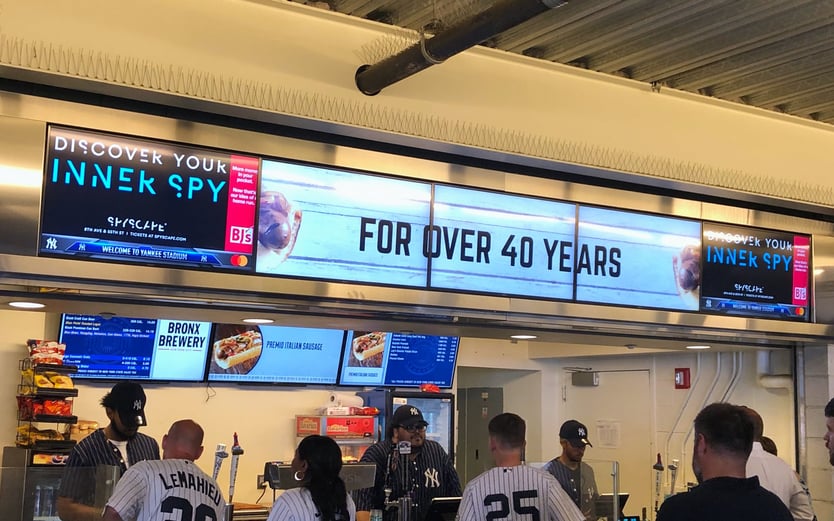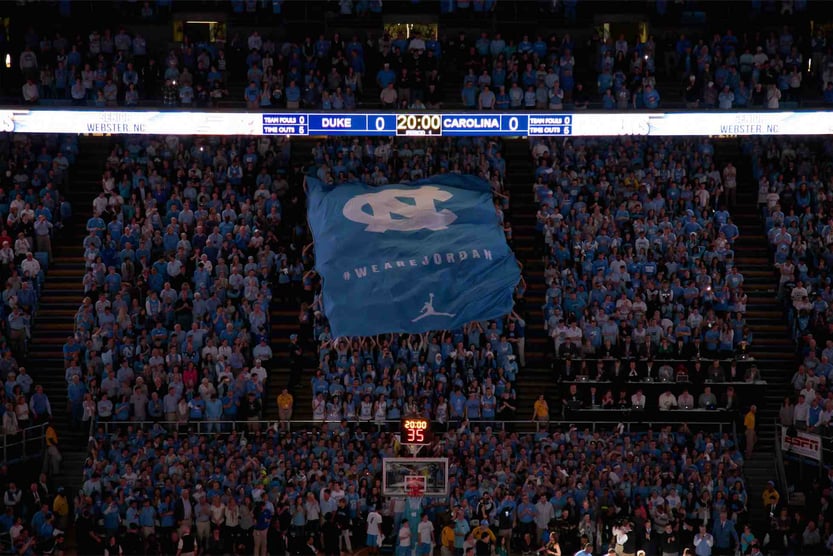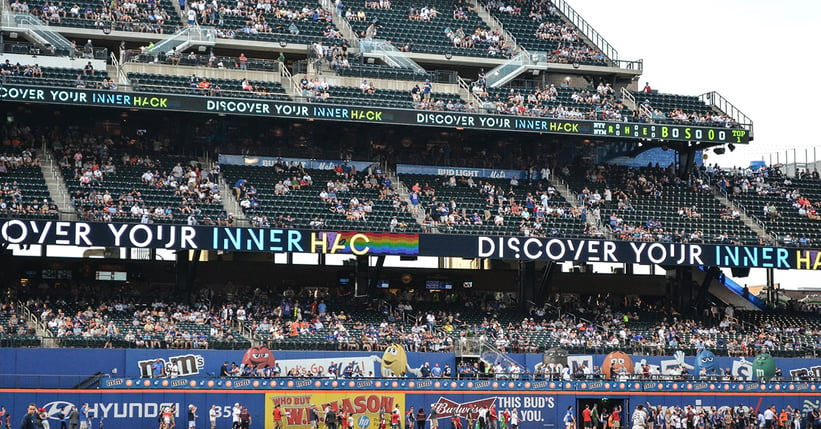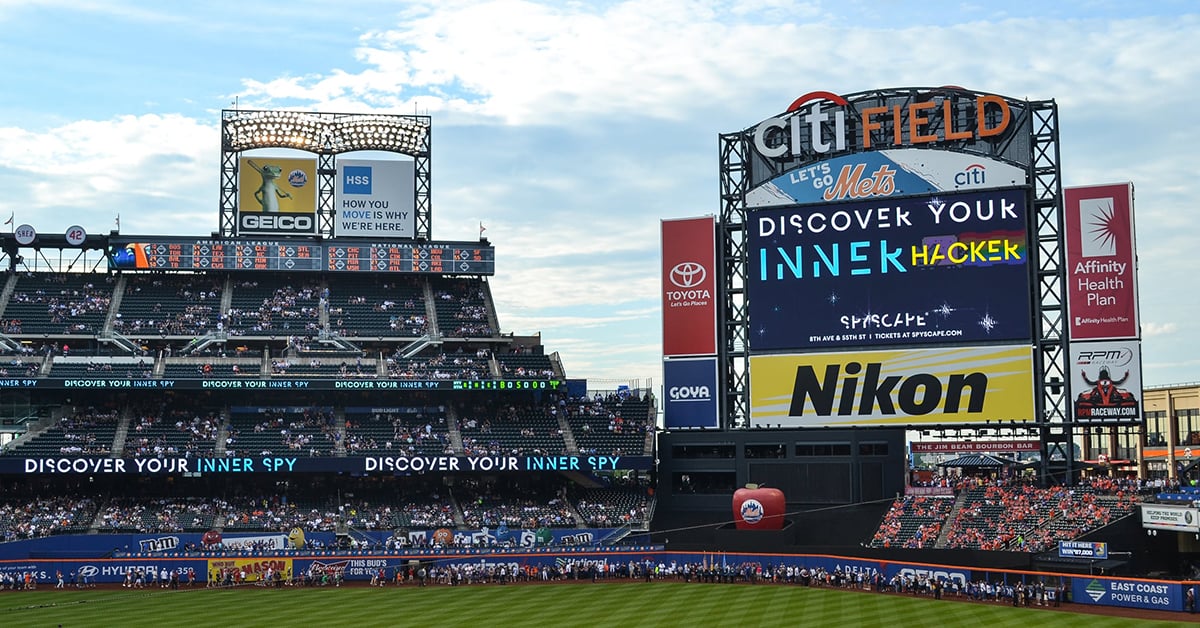Looking for a form of Out-of-Home (OOH) advertising that is primarily digital and has a low cost of entry? Sports Stadium and Arena advertising target a captive audience of event attendees. Events can include sporting events, concerts, or other live entertainment shows.
In this article, you’ll learn all about Stadium advertising. You'll learn how it builds brand awareness and targets a specific audience. You'll get ideas on how to use it in your next OOH campaign.

What Types of Formats are Available for Stadium Advertising?
Stadium and Arena advertisements can be inside or outside the stadium. They come in a variety of formats to reach your target audience, including:
- Signage: Large banners, posters, and signs are throughout the stadium or arena. They can be on walls, fences, scoreboards, or playing surfaces. Signage can be static or digital, allowing for dynamic content and targeted messaging.
- Scoreboard: The scoreboard is in the center of the stadium. There is usually digital signage. Commercials, sponsored content, or rotating banner ads are on the main scoreboard or LED screens. They reach audiences during breaks in the game or performance.
- Digital Screens: Some stadiums have digital screens throughout. They may also have digital screens on the concourses where people will walk through.
- Seat advertising: There is usually signage on the seats themselves. There are club seats that sit a little higher. Often additional banners run there.
- Sponsored-Advertising: Sport or league sponsors often have signs near the court. They get added exposures through broadcasting.
- Parking lot: These areas provide opportunities for wraps.
- Concourse Advertising: Ads along concourses and walkways capture fans moving around the venue. Ads can include posters, digital screens, interactive displays, or floor graphics.
- Jumbotron or Video Board Advertising: Jumbotrons are large video screens. They show advertisements during breaks in the action or between performances.
- Branded Areas: Sponsors may have exclusive branding rights to specific areas. Examples include entrances, seating sections, or concession stands. These areas can feature signage, digital displays, promotional materials, or branded decorations.
- In-Game or In-Event Promotions: Advertisements can integrate into the live event. Brands can make use of on-field branding, halftime shows, or sponsored contests. They can create memorable experiences and have direct interaction with the audience.
- Stadium Wraps: City permits can allow advertisers to wrap part of the stadium.
Many ads within a stadium will run through an ad network. The primary use of Stadium advertising is to market that stadium and the vendors within. Stadium or sports sponsors and partners of the athletes or teams also advertise.
Because the majority of inventory is digital, ads rotate on a screen. The rotation includes a mix of perm placements from brands that sponsor the stadium or team. It could also include perm advertisers who have an audience that aligns well. For example, gambling, especially sports gambling, is well aligned with a sports audience.
What Industries or Companies Benefit the most from Stadium Advertising?
Various local, nationwide, and international industries use Stadium and Arena advertising. Stadiums and arenas have specific, event-based audiences, which allows for behavioral targeting. Suppose a brand is curious about Stadium advertising. The brand should consider how it aligns with the event's demographic.

Often industries that use Stadium Advertising are more sports-oriented. Examples include gambling or active wear. For the most part, sports brands and adjacent companies try to enter these locations. Here are a few examples of types of companies that can benefit from Stadium advertising:
- Sports, Health, and Fitness Brands: Sports apparel and fitness brands showcase their products in sports venues. This helps them reach sports enthusiasts, athletes, and people with active lifestyles.
- Beverage and Food Companies: Soft drink brands, beer brands, snack companies, and fast food chains can advertise their products. These products are sold at concessions and food stands within the stadium.
- Automotive Companies: Those who can afford to attend sporting events have disposable income. Car dealerships can showcase their latest car models, SUVs, or trucks.
- Telecom and Technology Brands: Stadium advertising can be a great way to reach a diverse audience. Brands can sell mobile devices, internet services, or other technology-related products.
- Travel or Luxury Brands: Stadium advertising can be a great option if your brand targets those with more disposable income.
- Government Bodies: Local and regional governments may use Stadium advertising. They can share vital information or Public Service Announcements.
tend to cost more.
But nationwide sporting events, like the Superbowl, may be more expensive. Often for events like this, most advertisers will be direct sponsors of the sport. Consider whether the stadium's audience aligns with your company’s marketing objectives. A Stadium advertising campaign could be a great addition to your marketing mix if it does.
What are the Advantages of Stadium Advertising?
Stadium advertising can be very effective when it aligns with your brand and messaging. It reaches audiences in a very condensed manner and all at once - when an event occurs at the arena. Here are some of the benefits of Stadium advertising:
- Low-cost to Entry: It is primarily digital, which has no production costs.
- Flexibility: Advertisements can be bought on different schedules. This allows various audiences to see your message over time or for a specific game or event. Brands can cherry-pick certain games. Interior signage is usually purchased for an individual game. Exterior advertising, such as a Stadium Wrap, is generally bought by the week. A typical outdoor campaign in the US is four weeks long.
- Measurable: QR codes and website addresses on ads can be tracked. Some of the media are audited, which can help you understand the reach and frequency of the ad. Stadiums can provide average impressions based on how many people attend the event.
- Engaged and Captive Audience: Those who attend live shows or sporting events are often highly engaged with the experience. Their engagement with the event makes them more likely to remember your brand.
- Association with Sports and Entertainment: Stadium advertising associates brands with popular sports teams, athletes, or performers. This alignment taps into fans' emotional connection with their favorite teams or artists. This can positively impact brand perception and affinity.
- Targeted Marketing Opportunities: Stadiums attract specific demographics and target markets. For example, a football game may attract a primarily male audience. But a music concert may have a diverse age group and demographic. Companies can tailor their messaging to reach their intended target audience. Stadium advertising is excellent for targeting specific geographical areas. It can benefit local businesses or brands who want to increase visibility and market share in a particular region.
- Long Exposure Time: Sports events and live performances often have extended durations. Stadium advertising can provide continuous visibility throughout the event. It ensures a higher chance of message retention and brand recall.
- Enhanced Brand Visibility: Stadiums provide ample opportunities for brand visibility. They have many options that ensure a brand's message is prominently displayed. This creates widespread visibility and recognition.
Stadium advertising has many benefits. But its primary use is to build brand awareness and engagement.
How Can I Build Brand Awareness through Stadium Advertising?
Stadium advertising allows advertisers to buy brand moments. For example, if an athlete hits a significant milestone in their career. A brand may use the athlete's achievement to create promotional materials. Likewise, if a team has a historic season, a brand could highlight its success.
Critical moments for a brand can also be specific to that brand. For example, when launching a new product or creating a new partnership. Stadium advertisers can also use evergreen creatives to have a consistent voice in the market.
Live events often evoke strong emotions among fans. Connecting with a fan's relationship to the event helps build a strong brand image and foster a sense of loyalty and affinity.
Stadium advertising provides mass exposure through events that can attract thousands of attendees. Highly visible advertisements throughout a venue create brand familiarity.

What other OOH Formats go with Stadium Advertising?
Stadium advertising can be part of a larger OOH campaign strategy. Here are some ideas and examples of supporting formats for Stadium advertising campaigns:
- Rideshare/Taxi advertising: Advertisers can hire dozens of Rideshare Taxi Tops. The vehicles can swarm stadium grounds for a few-hour mini-domination.
- Traditional OOH Media: Find Bulletins or Wallscapes nearby or on highway arteries leading to the stadium.
- Subway/Transit Advertising: Many core stadiums have transit hubs that fans use to and from the Stadium. Some options include Station Dominations, Train Wraps, and Shuttle Bus ads.
- Projections: Projections on the side of a stadium-adjacent building catch traffic before and after an event. This allows advertisers to get next to a Stadium without a traditional medium.
- Mobile Billboards: These are great for building hype on the road to the stadium. They can also be around or near the stadium.
Get in the OOH Game with Billups
How can you leverage Stadium or Arena advertising to reach a targeted audience? At Billups, our OOH specialists are familiar with markets all over the globe. Let us help you build a high-impact OOH strategy that fits your budget. Contact us today.



